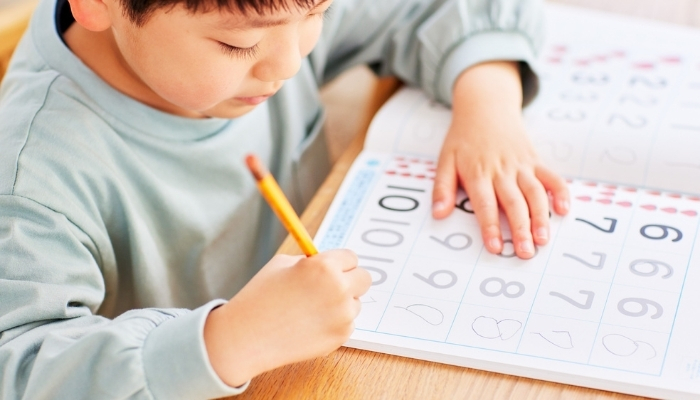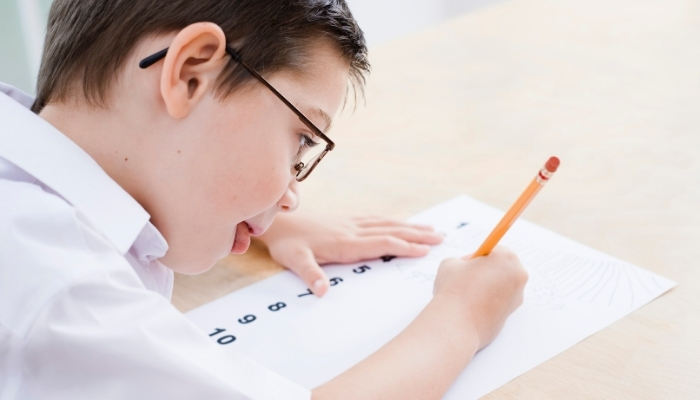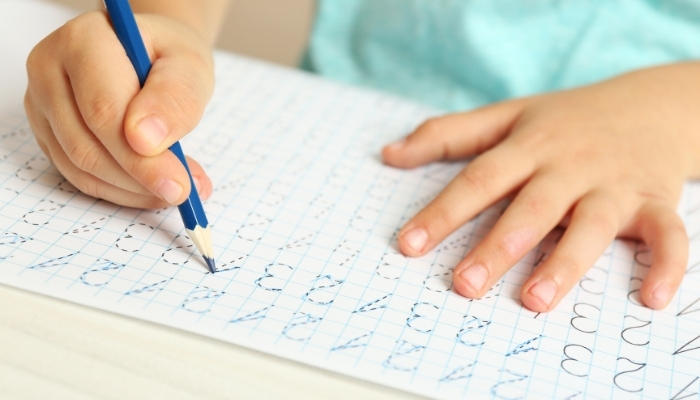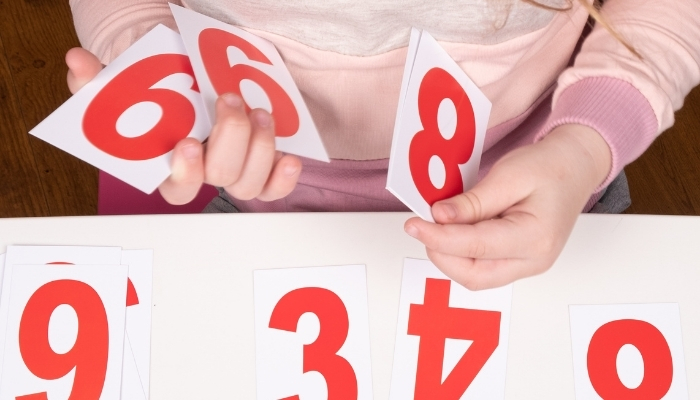Many parents notice their child can count up to ten easily, yet when asked to write those same numbers, the shapes come out reversed or wobbly. In other words, the child understands quantity but struggles with writing numbers in kindergarten.
That’s where guided practice comes in: simple, structured ways to help children connect the count with the correct numeral form. When kids learn to write numbers step by step, with strokes, guidance, and repetition, the symbols start to “feel right.” This builds confidence in both reading and math pathways.
This article explains how to write numbers in kindergarten, offers number writing activities for preschoolers and toddlers, and presents troubleshooting ideas for common hiccups. You’ll leave with hands-on strategies you can try today.
Key Takeaways
-
Early number writing for toddlers builds hand strength and confidence long before formal pencil work begins.
-
Writing numbers in kindergarten connects counting, movement, and meaning, turning memorization into true understanding.
-
Play-based number writing activities for preschoolers, like sand tracing or clay shaping, make learning fun and stress-free.
-
Small, consistent sessions (5–10 minutes) help children master strokes faster than long, tiring drills.
-
The FunFox Writers Club supports every child’s progress with expert teachers, interactive lessons, and a nurturing small-group environment.
Understanding Number Writing in Early Years
When we talk about writing numbers in kindergarten, it’s about more than copying shapes. It’s helping children connect what they see, say, and feel. Early exposure, like gentle number writing for toddlers, builds comfort with pencils, stroke control, and real understanding.

Each small effort, tracing a “2,” counting pebbles, or drawing a “5” in the air, strengthens coordination, focus, and confidence.
What Writing Numbers in Kindergarten Really Means
-
Learning the right strokes: Every number has a rhythm; a “2” starts with a curve, not a scribble.
-
Keeping it steady: Even size and spacing help children read their own writing proudly.
-
Making movement meaningful: Each stroke connects shape to quantity and meaning.
Why Early Exposure (Number Writing for Toddlers) Matters
-
Hands get ready first: Clay play or sand tracing builds strength for pencil control.
-
Familiarity brings comfort: Seeing and touching numbers early reduces hesitation later.
-
Play becomes practice: Drawing in dust or on foggy windows turns everyday fun into learning.
Connecting Writing to Number Sense
-
Numbers gain meaning: Writing “3” while counting three buttons links symbols to quantity.
-
Patterns appear naturally: Recognizing numerals helps children notice number order and rhythm.
-
Confidence grows: Each neat stroke builds belief in their own abilities.
Once your child feels at ease with writing numbers in kindergarten, new challenges may appear, reversed digits, uneven shapes, or shaky lines. The next section shows how to guide these moments with patience and playful practice.
Common Challenges in Writing Numbers in Kindergarten
As children start forming their first numerals, it’s natural to see uneven shapes, backward digits, or hesitation when picking up a pencil. These are not “mistakes”, they’re signs of learning in motion. Recognizing these patterns early helps parents guide practice gently and keep writing fun.
|
Challenge |
What It Looks Like |
Why It Happens |
How Parents Can Help |
|
Reversing numbers |
“5” written backward or “9” flipped |
Early writers focus on shape, not direction |
Use visual cues (arrows, rhymes) and consistent tracing routines |
|
Inconsistent sizing |
Big “3” next to tiny “4” |
Motor control is still developing |
Encourage writing on a grid or lined paper for spacing awareness |
|
Wrong stroke order |
Starting a “2” from the bottom |
Unsure where to begin each numeral |
Demonstrate slowly and narrate the stroke (“Curve around, then across”) |
|
Hand fatigue or shaky lines |
Lines appear wobbly or uneven |
Fine motor strength is still building |
Short sessions, soft-grip pencils, and frequent hand breaks |
|
Loss of focus or frustration |
The child avoids writing or rushes through |
Writing feels repetitive or tiring |
Keep sessions playful, add number writing activities for preschoolers, like tracing in sand or chalk outdoors |
|
Skipping or missing numbers |
Child jumps from 3 to 5 |
Still memorizing the sequence |
Use songs, counting games, and visual number lines for support |
Once parents understand what these challenges mean, the next step is building the right foundation, strengthening hands, control, and confidence before formal number writing begins. The following section focuses on those early-year building blocks that make writing smoother and stress-free.
Foundational Skills Before Number Writing
Before children start formal writing numbers in kindergarten, they need control, coordination, and curiosity. These early skills make number formation feel natural instead of frustrating.

Key Building Blocks
-
Finger strength: Activities like squeezing clay, threading beads, or playing with pegs build writing muscles.
-
Hand-eye coordination: Drawing lines, loops, and circles helps children track movement and shape direction.
-
Grip practice: Crayons or chunky pencils teach correct finger placement without strain.
-
Visual memory: Matching games and number cards help children remember what each numeral looks like.
-
Playful tracing: Sand, rice trays, or chalkboards offer a low-pressure way to “feel” the number before writing it.
Once these basics feel comfortable, it’s time to teach children how to write numbers in kindergarten, step by step, with structure and plenty of fun along the way.
Once your child feels confident with numbers, it’s the perfect time to build their storytelling skills. Read our guide on Kindergarten Story Writing Steps, Tips, and Techniques for Kids.
How to Write Numbers in Kindergarten- Step by Step
Learning to write numbers is one of the most exciting parts of early math. At this stage, children move from simply counting to expressing numbers through writing. Teaching how to write numbers in kindergarten works best when it’s playful, structured, and consistent.
Each short, engaging session helps children gain confidence and control, preparing them for fluent, legible writing. These steps work equally well for number writing for toddlers who are just starting to explore shapes and strokes.
Step 1: Start with Simple Numbers (1–3)
Introduce easy numerals first, those made of straight or simple curved lines. Model each number as you count aloud together.
Why it helps:
-
Builds early success through simple shapes.
-
Links count for writing for better understanding.
-
Encourages confidence before introducing trickier numbers.
Step 2: Model and Narrate Each Stroke
Show how to form every number while describing each movement, “Down, around, and stop” for 2, for example.
Why it helps:
-
Supports correct stroke order and direction.
-
Builds rhythm and flow in writing numbers in kindergarten.
-
Supports language learning by pairing words with action.
Step 3: Begin with Tracing, Then Move to Free Writing
Provide dotted outlines or guided arrows for tracing first. Gradually shift to writing independently once your child feels ready.
Why it helps:
-
Builds muscle memory for clean number formation.
-
Reduces frustration for early learners.
-
Encourages smoother transitions from number writing for toddlers to kindergarten practice.
Step 4: Add Visual Cues and Rhymes
Pair each numeral with a short rhyme or image, “A straight line down, now you’ve made a one!”
Why it helps:
-
Makes number writing easier to remember.
-
Keeps lessons playful and stress-free.
-
Encourages consistent recall during practice.
Step 5: Combine Paper Practice with Hands-On Play
Alternate pencil tasks with sensory activities, tracing in sand, shaping with clay, or writing on a chalkboard.
Why it helps:
-
Builds fine motor control through play.
-
Prevents boredom from repetitive pencil work.
-
Appeals to both visual and tactile learners.
Step 6: Keep Practice Short but Consistent
Schedule short 5–10 minute sessions daily instead of long writing blocks.
Why it helps:
-
Maintains focus and reduces fatigue.
-
Encourages routine without pressure.
-
Strengthens steady progress over time.
Before children learn to write numbers, they first need to recognize and count them. Learn more in Understanding the Importance of Counting and Number Recognition for Preschoolers.
Number Writing Activities for Preschoolers & Kindergarteners
Children learn best when movement, touch, and imagination come together. These number writing activities for preschoolers and kindergarteners turn simple practice into play, helping them master strokes, direction, and spacing while keeping learning joyful. They’re perfect for classrooms or home use and can even be adapted for number writing for toddlers who are just beginning to explore how numbers look and feel.

1. Sand or Salt Tray Writing
Children use their fingers to trace numbers in a shallow tray filled with sand or salt.
Why it helps:
-
Builds tactile memory and fine motor control.
-
Makes writing numbers in kindergarten more sensory and engaging.
-
Offers instant correction, just shake and start again!
2. Playdough Number Mats
Kids roll playdough into thin strips to shape each numeral on printed mats.
Why it helps:
-
Strengthens finger muscles for pencil control.
-
Turns how to write numbers kindergarten lessons into hands-on play.
-
Encourages creativity and repetition without pressure.
3. Chalk and Outdoor Tracing
Let children draw large numbers on the pavement or a chalkboard, tracing over them with different colors.
Why it helps:
-
Promotes big muscle movement for better coordination.
-
Strengthens stroke direction through repetition.
-
Keeps practice fun and energetic.
4. Finger Paint or Shaving Cream Numbers
Spread a thin layer of paint or foam on a tray and let kids trace numbers using their index fingers.
Why it helps:
-
Encourages sensory exploration while writing.
-
Builds comfort with shapes before holding a pencil.
-
Ideal for number writing for toddlers who are still building control.
5. Pom-Pom Path Counting
Print large numbers and have children place pom-poms along each stroke. They can count aloud as they go.
Why it helps:
-
Connects counting with number formation.
-
Strengthens one-to-one correspondence.
-
Keeps writing numbers in kindergarten, interactive and playful.
6. Roll and Write Game
Children roll a dice, then write the number that appears using a pencil, marker, or crayon.
Why it helps:
-
Supports number recognition through repetition.
-
Adds excitement and unpredictability to practice.
-
Encourages confidence with each correct numeral.
7. Tracing with Everyday Objects
Use small items like beads, buttons, or pasta pieces to outline printed numerals.
Why it helps:
-
Builds precision and attention to shape.
-
Encourages creativity and sensory input.
-
Helps children remember how each number feels and looks.
Sample Practice Plan (First Month)
This four-week plan keeps lessons short, playful, and achievable. Parents can adapt each activity based on their child’s comfort level. The goal is consistency and enjoyment, not perfection.
|
Week |
Focus Area |
Daily Practice Ideas |
Parent Tip |
|
Week 1 |
Building comfort with numbers 1–3 |
Trace with fingers in sand, rice, or salt trays; say the number aloud as they write. |
Keep sessions short (5 minutes). Praise effort, not just neatness. |
|
Week 2 |
Introducing numbers 4–5 |
Use chalk or crayons for large writing; pair each number with a short rhyme. |
Encourage storytelling, ask, “Where do we see this number every day?” |
|
Week 3 |
Review 1–5 and start 6–7 |
Mix tracing and free writing; shape numbers with playdough. |
Alternate between paper and sensory play to keep engagement high. |
|
Week 4 |
Writing 8–10 and full review |
Create a mini “number book”, one page per numeral; decorate with stickers or drawings. |
End each session with positive feedback, and small celebrations build confidence. |
As children start enjoying these simple number writing games, you’ll likely see small but meaningful changes, a steadier grip, neater shapes, and growing pride in their work. These moments matter more than perfection. The next step is learning how to notice that progress, celebrate it, and gently guide your child when something feels tricky.
Once your child feels confident writing numbers, keep their curiosity growing with Fun and Engaging Number Activities for Preschoolers: Sparking a Love for Learning Math.
Progress Checking & Troubleshooting
When children start writing numbers in kindergarten, progress shows up quietly, a steadier grip, a smoother curve, a proud smile after writing “4” just right. These little changes mean your child’s confidence and coordination are growing. This stage isn’t about perfection; it’s about noticing effort and offering gentle support when something feels tricky.
|
What You Might See |
What It Tells You |
How You Can Support |
|
Numbers are clearer and more even |
Their hand strength and control are improving |
Keep practice short and encouraging, a few minutes a day is enough |
|
Some numbers appear backward (like 3 or 7) |
They’re still learning direction and shape memory |
Trace together slowly, saying each stroke aloud to build awareness |
|
Numbers look uneven or spread out |
They’re figuring out spacing and proportion |
Try larger paper or grid boxes so writing feels more manageable |
|
Child sighs or avoids writing |
They might feel tired or unsure |
Pause and shift to a playful task, chalk writing, or tracing in rice |
|
Good days and off days |
They’re still settling into consistency |
Celebrate effort over neatness; confidence grows with calm reassurance |
|
Prefers tracing over free writing |
They’re not fully ready for independent strokes |
Mix tracing and free writing, gentle repetition builds control naturally |
How FunFox Builds Confident Young Writers
FunFox turns writing into a fun, creative, and confidence-building experience. Through The Writers Club, our teachers help children express their ideas clearly, strengthen their writing skills, and discover the joy of storytelling.

FunFox’s structured approach provides your child with focused, high-quality writing instruction that supports literacy, imagination, and lifelong communication skills.
Here’s how The Writers Club helps your child grow as a writer:
-
Expert-Guided Teaching: Our teachers are trained in the FunFox Way, combining creativity with structured language learning. They guide each child through storytelling, sentence structure, and expression, making writing enjoyable and purposeful.
-
Interactive and Game-Based Learning: Every lesson includes word games, writing prompts, and group storytelling that bring writing to life. Children learn grammar, punctuation, and vocabulary naturally through play and collaboration.
-
Small Group Sessions: Each Writers Club class has only 3–6 students, allowing teachers to give individual feedback while encouraging peer sharing. Students benefit from hearing different perspectives and learning in a supportive space.
-
Weekly Online Lessons: Students join one-hour live Zoom sessions each week. Families can choose a convenient time, and every class is recorded so children can revisit lessons anytime.
-
Ongoing Feedback and Parent Connection: Our teachers provide regular, constructive feedback that helps children see their progress. Parents receive updates and simple at-home tips to continue building writing confidence between lessons.
-
Engaging Resources and Materials: Members gain access to the FunFox digital learning portal, filled with interactive worksheets, creative exercises, and fun literacy games, all designed to make writing feel exciting, not stressful.
The FunFox Writers Club helps children aged 6–12 (Years 1–7) build language skills and creative confidence in a warm, nurturing environment.
Conclusion
Learning to write numbers is a small skill with a big impact. When children master writing numbers in kindergarten, they begin to connect counting, movement, and meaning. Many parents see their child count fluently yet struggle to shape the numbers clearly. Practicing how to write numbers kindergarten style, through repetition, play, and gentle guidance, helps turn shaky lines into confident strokes.
At FunFox, we make this process joyful. Through playful number writing activities for preschoolers and hands-on support for number writing for toddlers, children build control, focus, and pride in every lesson. Our small-group classes and caring teachers create an encouraging space where learning feels exciting and personal.
Join the FunFox Writers Club today and make learning to write an experience they’ll love, one number, one word, one proud smile at a time.
FAQs About Writing Numbers in Kindergarten
1. At what age should my child start writing numbers?
Most children begin writing numbers in kindergarten, usually between the ages of four and six. Younger learners can try simple number writing for toddlers tasks like tracing in sand or air writing with their fingers.
2. How can I help if my child reverses numbers?
It’s a normal part of learning. Encourage slow tracing, saying each stroke out loud, and using arrows to remind them of the right direction.
3. My child gets tired quickly. What should I do?
Keep practice short and playful. Five focused minutes using number writing activities for preschoolers, such as chalk writing or clay shaping, builds strength without stress.
4. How often should we practice number writing?
A few minutes daily works best. Consistency helps children remember shapes and strokes more naturally.
5. How does FunFox help children learn to write numbers?
FunFox’s Writers Club makes writing numbers in kindergarten and early literacy fun through small-group lessons, interactive feedback, and creative, hands-on activities that nurture confidence and skill.















